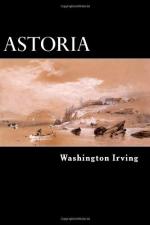It is surprising to notice how well this remote tribe of savages had learnt, through intermediate gossips, the private feelings of the colonists at Astoria; it shows that Indians are not the incurious and indifferent observers that they have been represented. They told Mr. Hunt that the white people at the large house had been looking anxiously for many of their friends, whom they had expected to descend the great river; and had been in much affliction, fearing that they were lost. Now, however, the arrival of him and his party would wipe away all their tears, and they would dance and sing for joy.
On the 31st of January, Mr. Hunt arrived at the falls of the Columbia, and encamped at the village of the Wish-ram, situated at the head of that dangerous pass of the river called “the Long Narrows”.
CHAPTER XXXVIII.
The Village of Wish-ram.—Roguery
of the Inhabitants.—Their
Habitations.—Tidings
of Astoria.—Of the Tonquin Massacre.
—Thieves
About the Camp.—A Band of Braggarts—Embarkation.—
Arrival at Astoria.—A
Joyful Reception.—Old Comrade.—
Adventures of Reed,
M’Lellan, and M’Kenzie Among the Snake
River Mountains.—Rejoicing
at Astoria.
Of the village of Wish-ram, the aborigines’ fishing mart of the Columbia, we have given some account in an early chapter of this work. The inhabitants held a traffic in the productions of the fisheries of the falls, and their village was the trading resort of the tribes from the coast and from the mountains. Mr. Hunt found the inhabitants shrewder and more intelligent than any Indians he had met with. Trade had sharpened their wits, though it had not improved their honesty; for they were a community of arrant rogues and freebooters. Their habitations comported with their circumstances, and were superior to any the travellers had yet seen west of the Rocky Mountains. In general, the dwellings of the savages on the Pacific side of that great barrier were mere tents and cabins of mats, or skins, or straw, the country being destitute of timber. In Wish-ram, on the contrary, the houses were built of wood, with long sloping roofs. The floor was sunk about six feet below the surface of the ground, with a low door at the gable end, extremely narrow, and partly sunk. Through this it was necessary to crawl and then to descend a short ladder. This inconvenient entrance was probably for the purpose of defense; there were loop-holes also under the eaves, apparently for the discharge of arrows. The houses were large, generally containing two or three families. Immediately within the door were sleeping places, ranged along the walls, like berths in a ship; and furnished with pallets of matting. These extended along one half of the building; the remaining half was appropriated to the storing of dried fish.




